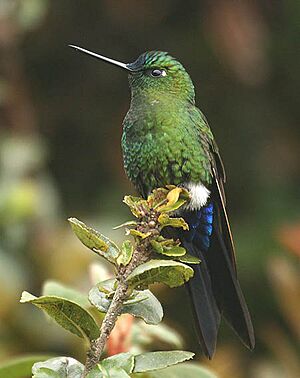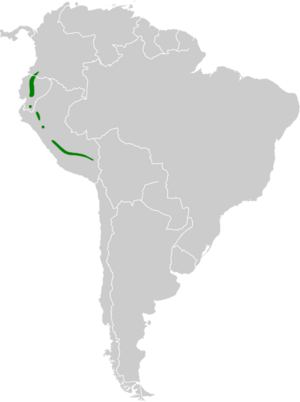Sapphire-vented puffleg facts for kids
Quick facts for kids Sapphire-vented puffleg |
|
|---|---|
 |
|
| Conservation status | |
| Scientific classification | |
| Genus: |
Eriocnemis
|
| Species: |
luciani
|
 |
|
The sapphire-vented puffleg (Eriocnemis luciani) is a type of hummingbird. It belongs to a group of hummingbirds called "brilliants." You can find this bird in countries like Colombia, Ecuador, Peru, and maybe even Venezuela.
Contents
About the Sapphire-Vented Puffleg
This hummingbird is about 11.4 to 14 centimeters (4.5 to 5.5 inches) long. It weighs around 5.4 to 6.4 grams (0.19 to 0.23 ounces). It has a straight, black beak.
What Does It Look Like?
The male sapphire-vented puffleg has shiny green feathers on its back. Its head has a bright dark blue patch. Its belly is mostly a sparkling golden-green. It has a shimmering purple area near its tail. White fluffy feathers, called "puffs," are on its legs. Its tail is blue-black and deeply forked, like a "V" shape.
The female bird is a little smaller than the male. Her tail is not as deeply forked. However, her feathers look very similar to the male's.
There are a few different kinds of sapphire-vented pufflegs. Some might have more bronze-green feathers. Others might have a coppery shine on their heads. Some types might not have the blue patch on their heads.
Where Do These Birds Live?
The sapphire-vented puffleg lives in the Andes Mountains in South America. You can find them in Colombia, Ecuador, and Peru. One type of this bird, called E. l. meridae, was found in Venezuela a long time ago. However, it might not exist anymore.
Their Mountain Home
These hummingbirds like to live in wet mountain forests. They especially enjoy "elfin forests," which have small, twisted trees. They also live in areas with Polylepis trees and brushy grasslands called páramo.
In Ecuador, they live at heights between 2,700 and 3,700 meters (8,900 and 12,100 feet) above sea level. In Peru, they are found between 2,400 and 3,500 meters (7,900 and 11,500 feet) high.
How They Live Their Lives
Feeding Habits
The sapphire-vented puffleg eats nectar from flowers. It often feeds close to the ground. It holds onto the flowers of shrubs and small plants while it sips nectar. They have been seen feeding on plants like mistletoe and others. Like most hummingbirds, they also eat small insects.
Reproduction and Life Cycle
Scientists don't know much about how these birds raise their young. One nest that was found was made of moss, lichen, fern leaves, and spiderwebs. It was hanging from a thin branch in thick grass. This nest held two white eggs.
Bird Calls
The call of the sapphire-vented puffleg sounds like a sharp "tirr tirr."
Conservation Status
The sapphire-vented puffleg is considered a species of "Least Concern." This means that it is not currently in danger of disappearing. Scientists believe their numbers are stable, even though they don't know exactly how many there are.
There are no major threats to these birds right now. Human activities don't seem to affect them much, except for local habitat destruction.
Images for kids



